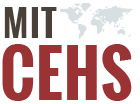If an infection disease was killing 7 million people a year, it would be ludicrous to work to allay its impact decades from now rather ... READ MORE
Immunization strategy could prevent gastrointestinal disease.
Chemists discover structure of bacterial enzyme that generates useful polymers.
Newly discovered genetic code controls bacterial survival during infections.
Could chemicals key to sustainable technologies pose unseen environmental risks?
A major study about the best way to treat early-stage breast cancer reveals that "precision medicine" doesn't provide unambiguous answers about how to choose the best therapy.
Professor Colette Heald will serve as associate department head; Profess Jesse Kroll will chair the Graduate Education Committee.
"Human waste in sewage may yield insights on disease outbreaks, superbugs and other health issues." Read the WSJ article.
A specific type of stimulus of the immune system in early life leads to a healthy adulthood. Read More.
The deadline for this submission has passed.
The CEHS invites MIT faculty and research staff with Principal Investigator privileges to submit applications for funding of pilot projects related to basic and translational research in environmental health sciences. Please see the attached flier for more information.
Funding will start on September 1, 2016. Please feel free to contact Amanda Tat if you have any further questions.
House dust mites, which are a major source of allergens in house dust, can cause asthma in adults and children. Researchers from MIT and the National University of Singapore have now found that these mites have a greater impact than previously known — they induce DNA damage that can be fatal to lung cells if the damaged DNA is not adequately repaired.
Local recurrence is a common cause of treatment failure for patients with solid tumors. Intraoperative detection of microscopic residual cancer in the tumor bed could be used to decrease the risk of a positive surgical margin, reduce rates of reexcision, and tailor adjuvant therapy. We used a protease-activated fluorescent imaging probe, LUM015, to detect cancer in vivo in a mouse model of soft tissue sarcoma (STS) and ex vivo in a first-in-human phase 1 clinical trial. In mice, intravenous injection of LUM015 labeled tumor cells, and residual fluorescence within the tumor bed predicted local recurrence. In 15 patients with STS or breast cancer, intravenous injection of LUM015 before surgery was well tolerated. Imaging of resected human tissues showed that fluorescence from tumor was significantly higher than fluorescence from normal tissues. LUM015 biodistribution, pharmacokinetic profiles, and metabolism were similar in mouse and human subjects. Tissue concentrations of LUM015 and its metabolites, including fluorescently labeled lysine, demonstrated that LUM015 is selectively distributed to tumors where it is activated by proteases. Experiments in mice with a constitutively active PEGylated fluorescent imaging probe support a model where tumor-selective probe distribution is a determinant of increased fluorescence in cancer. These co-clinical studies suggest that the tumor specificity of protease-activated imaging probes, such as LUM015, is dependent on both biodistribution and enzyme activity. Our first-in-human data support future clinical trials of LUM015 and other protease-sensitive probes.
Mercury is a globally transported pollutant with potent neurotoxic effects for both humans and wildlife. This study introduces an assessment method to estimate the potential human health-related economic benefits of global and domestic mercury control policies. It finds that for the US population as a whole, global mercury controls could lead to approximately twice the benefits of domestic action by 2050. This result is robust to several uncertainties and variabilities along the emissions-to-impacts path, although we find that those consuming locally caught freshwater fish in the United States could benefit more from domestic action.

